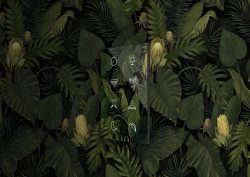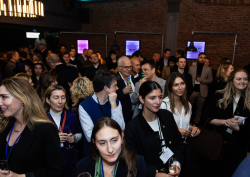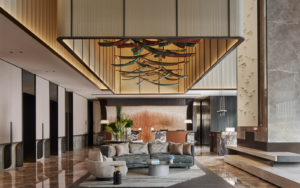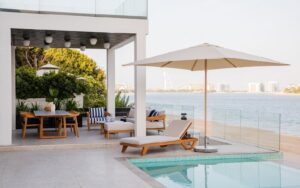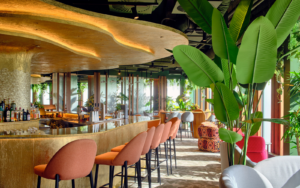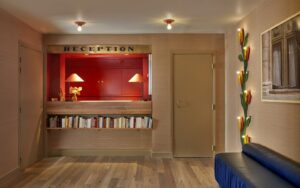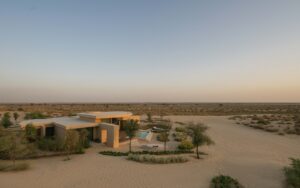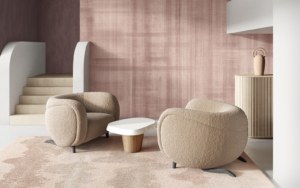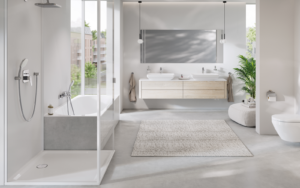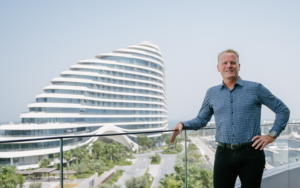When it comes to interior design trends for 2023, the year is, according to Interior Designer Benji Lewis, “all about bold colours, 70’s glamour and an opportunity to introduce personal style and vigour to a space.” We thought we would take a look at how these trends will translate into the hospitality arena…

Benji Lewis is an established British interior designer whose extensive experience working on residential and commercial properties has included spaces from studios to town and country houses, listed properties and commercial spaces. Responding to social changes and picking up on trends has allowed him to pivot his business model into the realm of virtual consultation with Zoom that Room. He has drawn on all this experience to give us some interior design trends and touchpoints for 2023, which we have sensitively taken and married against shining hotel design examples.
“Deep jewel colours – amethyst, blue, jade and lapis for example – used in an immaculately tailored fashion are looking good.” – Benji Lewis.
In the hospitality arena, the use of jewel colours and rich textures always gets our attention when picking out emerging interior design trends. The team at David Collins Studio embraced these hues in Corinthia London’s new cocktail bar, Velvet. The furniture, upholstered in shades of red and royal blue, and deep velvet curtains, provide a glamorous feel, alongside convex mirrors and lavish lighting.
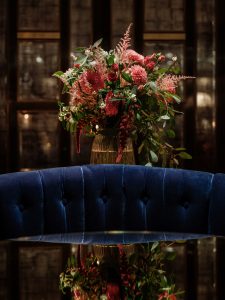
Image credit: Alex Upton
Bergman Design House used these colours to make a strong statement in hotels like The Other House, and venues like Bagheera, where guests are greeted with a sumptuous cocktail lounge in hues of gold, deep red, teal and imperial purple.
“Pattern is contained to include just a simple geometric or stripe.” – Benji Lewis.
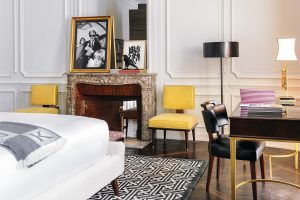
Image credit: J.K. Place Paris
Integral to strong design is getting that balance between layers of colour and pattern – we all have our tipping point from the austere approach of minimalist through to exuberant maximalists. The key to successful use of pattern in the hospitality arena where design has to appeal to a broad cross section of guests, is as Lewis suggests, a curated approach to pattern. The interiors of J.K. Place Paris illustrate the point perfectly as pattern traverses design both in fabrics, floors and accessories but is consistently part of a bigger design picture and importantly, is never overpowering.
“Mid-century eclectica is going to be strong, but used in a chic paired-back fashion in a blend of textures rather than anything cluttered. For example, a lacquered sideboard with a statement ceramic lamp, with linen shade, and a single good piece of glass will pack way more of a punch rather than multiple baubles and trinkets.” – Benji Lewis.
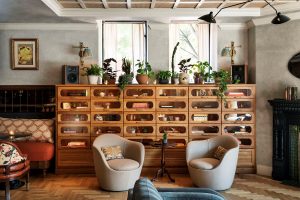
Image credit: The Quoin / Matthew Williams
The in-house design firm Method Studios makes full use of layering mid-century design with other elements to create a full story of its location in The Quoin. The building’s existing natural materials were emphasised by layering in modern handmade décor with the clean lines of modern Shaker-influenced furniture, and an overall subdued, earthy colour palette influenced by original Victorian-era paints dating back to 1820.
With an increasing interest in the repurposing of buildings within the hospitality industry – think less interior design trends and more socially doing the right thing – a lot of the structures fall into the realm of mid-century modern, making a clear case for these design elements to be incorporated without resorting to pastiche.
“Glamour is back in all its ‘70s smokey-glass fashion – think low seated lounge sofas, with built-in acrylic end tables, sumptuous leafy woven fabrics in mid-brown shades with forest green and gold.” – Benji Lewis.
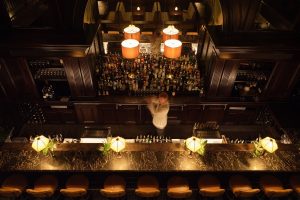
Image credit: The Ned NoMad
Glamour is unquestionably back! And if you were in any doubt, a quick run through some Hotel Designs’ posts from Manhattan to Madrid will illustrate the point. From bespoke bars, retro cocktails, and low slung sofas – hotels are clamouring for the top podium in the smoky glass stakes as the importance of creating both moments in time as well as beautifully designed spaces with stories becomes as important as the contents of the cocktail shaker. Aside from the ’70s inspired glamour of it all, those hues of green and brown in this trend forecast also play right into the biophilic mood of the moment.
“Lighting is one [element] that we just want to get better and better at. Blend wall lighting with a statement table lamp, consider a wash of light being cast over the floor with skirting height recessed wall lights, but absolutely do not think a single pendant light (however beautiful) will cut the mustard on its own when it comes to providing a strong ambient feel to your space, because it won’t.” – Benji Lewis.

Image credit: Mel Yates
Take this statement about lighting interior design trends and multiply it by 10 when it comes to hotel and hospitality design. From the practical to the playful, lighting has a role to play in every corner of the room. Guestroom lighting has to be thought through and impeccable, as well as intuitive and easy to use. In the public areas it can increase guests sense of wellbeing, entice guests in though a sense of the dramatic, redefine a space and curate a design. Lighting can quite literally be all things to all people in the hotel environment.
The design team at Taylor Howes Design harnessed the forces of lighting in the design for Chateau Denmark to create drama and extend the narrative of the property from the moment you step through the doors. collaborating with Northern Lights on this project, every element was carefully considered and layered. “Our aim was to craft lighting solutions from scratch that would not only create the right ambience and illumination, but that would also form an integral part of the storytelling,” said Kevin Swart, Sales Director, Northern Lights.
In contrast, and with more of an emphasis on maximising natural lighting and less of a penchant for the dramatic, Buckle Street Studios by Locke illustrates the point that clever and layered lighting is not confined to the realm of the dark and moody interior. Layered and focussed lighting is used throughout the design to both highlight the design and to soften its edges.
“We’ve all got the memo about upcycling, it’s now hardwired into our thinking and certainly won’t be on the wane in 2023.” – Benji Lewis.
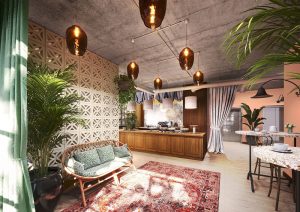
Image credit: room2
No discussion on upcycling and sustainability can be had without mentioning room2 Chiswick. Having claimed the spot as ‘the worlds first net-zero hometel’, and after winning Hotelier of the Year at The Brit List Awards 2023, it has set the bar high. From fabrics to flooring, materials have been mindfully chosen to promote reuse, such as soft bedroom throws from Slow Down Studio, which are made from 80 per cent recycled cotton, and carpets constructed using recycled fishing nets which line the corridors. Architects, designers and manufacturers are all responding to consumer demands as well as challenging us and the overriding feeling is that the (recycled) surface has only been scratched.
“Look at incorporating architectural detail like panelling in your room schemes, referencing the Savoir office in Emily in Paris, have it painted in the same colour as the walls so the whole room blends as one.” – Benji Lewis.
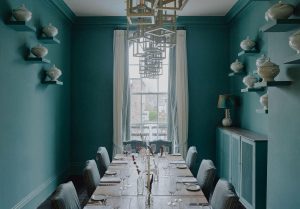
Image credit: GuestHouse
Luckily you don’t have to be Emily, or go to Paris, to appreciate the impact of colour-on-colour architectural details. A wander around the boutique space of No1 York should be enough to convince you of the appeal of colour saturation and architectural details. Hotels like The Other House have also skilfully incorporated this into the design to add detail and layers of interest and as a useful tool when crossing between period details and contemporary design.
As with all interior design trends, they are there to guide and inspire rather than dictate. At a time when the boundaries between work and play, home and hospitality, are being increasingly blurred it is interesting to see trends crossover and become reimagined in spaces that are by necessity designed with both longevity and curb appeal in mind. Scrolling through these references, it is clear that hotel design has moved far beyond the beige of neutral mass appeal and is in fact setting trends rather than following them.
Main image credit: Proper Hotels / The Ingalls



